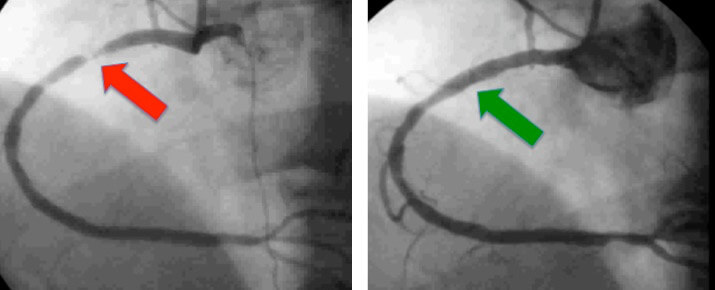Coronary Angiography +/- Angioplasty and Stenting

Example of coronary angiogram of a 55 year old gentleman with chest pain. Image on the left shows the right coronary artery with a severe narrowing (red arrow). Image on the right was taken after angioplasty and stenting showing resolution of the narrowing.
What is a coronary angiogram?
It is an invasive test performed in hospital to look for narrowings or blockages in the blood vessels that supply the heart. If a significant narrowing or blockage is found that appears suitable, your cardiologist may proceed immediately to perform angioplasty and stenting. Your cardiologist will discuss this possibility with you prior to the procedure. Angioplasty and stenting refers to the procedure whereby the narrowing in the blood vessel is dilated and a stent is deployed to keep the vessel patent.
You can elect to have this procedure at a public or private hospital as our cardiologists are accredited at both types of institutions. You can discuss the pros and cons of public versus private hospitals with your cardiologist.
How is a coronary angiogram performed?
Coronary angiography is only performed by a fully trained and experienced cardiologist. This procedure is performed under light sedation and local anaesthetic. A sheath is placed into a blood vessel either at your wrist or at the top of your leg. A catheter or tube is advanced via this sheath to the blood vessels supplying the heart under X-ray guidance. A series of digital video clips are then obtained using X-ray by injecting contrast medium into these blood vessels.
How is a coronary angioplasty and stenting performed?
Should you have significant coronary artery disease on angiogram that is amenable to angioplasty, your cardiologist may decide to proceed. Using the same sheath used for your angiogram, a specialized catheter or tube will be used to engage the relevant artery. A fine wire will then be advanced into the artery across the narrowing. This wire will be used to guide a small balloon to the site of the narrowing. The balloon is expanded to dilate the narrowing. A stent, which is a small alloy mesh in the shape of a cylinder, is usually placed at the site of the narrowing to prevent re-narrowing at this site. The balloon is then removed from the body.
Why is a coronary angiogram performed?
Coronary angiography is the gold standard method to evaluate narrowings or blockages in the blood vessels that supply the heart. It is used to diagnose the cause of certain symptoms like chest pain or shortness of breath. It is also used to determine a patient’s risk of suffering a heart attack.
Do I need to prepare for coronary angiogram +/- angioplasty and stenting?
Yes. You will need to have had recent blood tests. You should fast (no breakfast or drink) on the morning of the test. You should inform your cardiologist if you have had a contrast (X-ray dye) reaction before so that proper precautions can be taken. Your cardiologist may instruct you to take certain blood thinning drugs in preparation for the procedure, and in general you should continue all your usual pills, unless instructed otherwise.
If uncomplicated, a coronary angiogram is a day-stay procedure, and you should expect to spend at least 6 hours in hospital. Patients who undergo angioplasty and stenting are usually required to stay 1 night in hospital.
Are there any risks associated with coronary angiography and angioplasty?
There are small but significant risks associated with a coronary angiogram and coronary angioplasty. Your cardiologist would not have recommended this procedure unless he/she believes that the risk of not doing the procedure outweighs the risk of undergoing the procedure. Your cardiologist will discuss the risks and benefits of undergoing this procedure prior to scheduling you.
